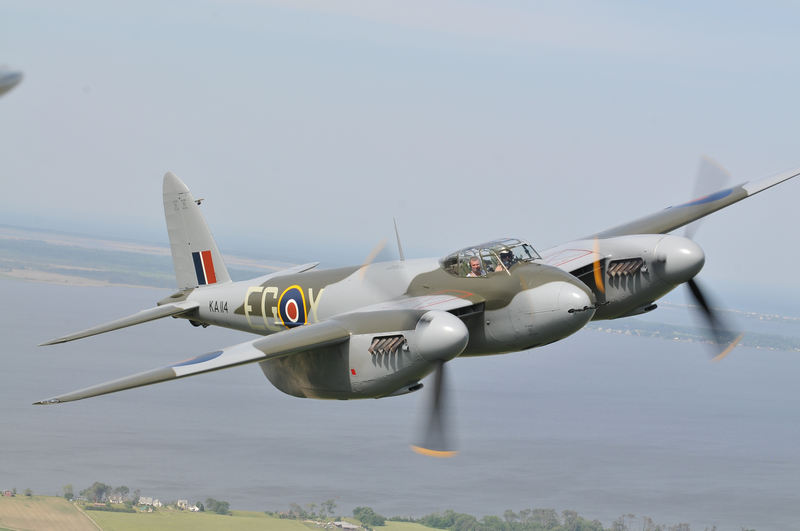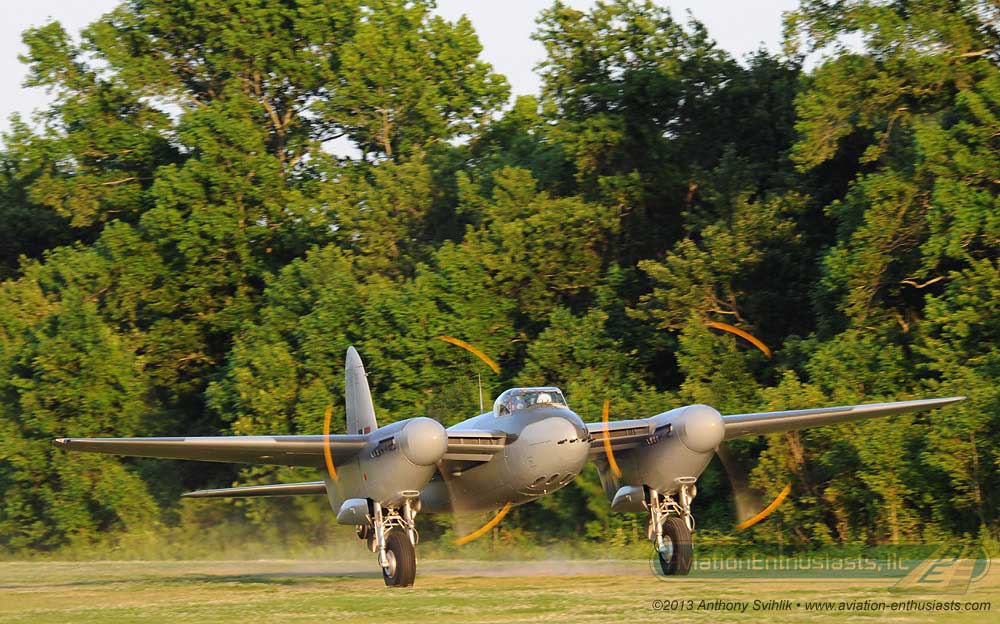One of the most useful Allied aircraft of World War II, the Mosquito performed as a bomber, fighter, anti-shipping and photo-reconnaissance platform. The key to the success of the “Wooden Wonder” was its light wood construction and the power of its twin Merlin engines, which gave it the speed to out-fly almost every other aircraft type of the war. Nicknamed the “Mossie” by its crews, the Mosquito could fly virtually unchallenged and deliver devastatingly precise attacks with bombing radar.

Production of all Mosquitoes totaled 7,781 and the DH.98 served with over a dozen nations. A Mosquito became the first twin-engine aircraft to land on a ship on March 25, 1944, aboard the Royal Navy aircraft carrier HMS Indefatigable.

Here is a photo of the DH.98 Mosquito from the Military Aviation Museum in Virginia Beach, Virginia taking-off during the 2013 Flying PROMS airshow.
This Mosquito was built in Canada in 1945 but never saw combat during the war. The Military Aviation Museum acquired the aircraft in 2004 and it was shipped to New Zealand to undergo an eight-year restoration. The restored aircraft made its first flight (clicky) here in New Zealand in September 2012 and arrived back at the Military Aviation Museum in March 2013. It is painted as EG-Y to replicate the No. 487 (NZ) Squadron of the Royal New Zealand Air Force as a tribute to those responsible for the restoration.
Wiki: The de Havilland DH.98 Mosquito was a British multi-role combat aircraft with a two-man crew that served during and after the Second World War. It was one of few operational front-line aircraft of the era constructed almost entirely of wood and was nicknamed "The Wooden Wonder".
The Mosquito was also known affectionately as the "Mossie" to its crews. Originally conceived as an unarmed fast bomber, the Mosquito was adapted to roles including low to medium-altitude daytime tactical bomber, high-altitude night bomber, pathfinder, day or night fighter, fighter-bomber, intruder, maritime strike aircraft, and fast photo-reconnaissance aircraft. It was also used by the British Overseas Airways Corporation (BOAC) as a fast transport to carry small high-value cargoes to, and from, neutral countries, through enemy-controlled airspace.
When the Mosquito began production in 1941, it was one of the fastest operational aircraft in the world. Entering widespread service in 1942, the Mosquito was a high-speed, high-altitude photo-reconnaissance aircraft, continuing in this role throughout the war. From mid-1942 to mid-1943 Mosquito bombers flew high-speed, medium or low-altitude missions against factories, railways and other pinpoint targets in Germany and German-occupied Europe. From late 1943, Mosquito bombers were formed into the Light Night Strike Force and used as pathfinders for RAF Bomber Command's heavy-bomber raids. They were also used as "nuisance" bombers, often dropping Blockbuster bombs - 4,000 lb (1,812 kg) "cookies" - in high-altitude, high-speed raids that German night fighters were almost powerless to intercept.
As a night fighter, from mid-1942, the Mosquito intercepted Luftwaffe raids on the United Kingdom, notably defeating Operation Steinbock in 1944. Starting in July 1942, Mosquito night-fighter units raided Luftwaffe airfields. As part of 100 Group, it was a night fighter and intruder supporting RAF Bomber Command's heavy bombers and reduced bomber losses during 1944 and 1945.
As a fighter-bomber in the Second Tactical Air Force, the Mosquito took part in "special raids", such as the attack on Amiens Prison in early 1944, and in precision attacks against Gestapo or German intelligence and security forces. Second Tactical Air Force Mosquitos supported the British Army during the 1944 Normandy Campaign. From 1943 Mosquitos with RAF Coastal Command strike squadrons attacked Kriegsmarine U-boats (particularly in the 1943 Bay of Biscay, where significant numbers were sunk or damaged) and intercepting transport ship concentrations.
The Mosquito flew with the Royal Air Force (RAF) and other air forces in the European, Mediterranean and Italian theatres. The Mosquito was also operated by the RAF in the South East Asian theatre, and by the Royal Australian Air Force (RAAF) based in the Halmaheras and Borneo during the Pacific War.







